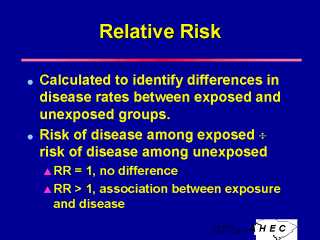| front |1 |2 |3 |4 |5 |6 |7 |8 |9 |10 |11 |12 |13 |14 |15 |16 |17 |18 |19 |20 |21 |22 |23 |24 |25 |26 |27 |28 |29 |30 |31 |32 |33 |34 |35 |36 |37 |38 |39 |40 |review |
 |
Relative risk is calculated to identify differences in the rate of a disease between exposed and unexposed (to a risk) groups. It is calculated by dividing the risk of disease in the exposed population by the risk of disease in the unexposed population. If the Relative Risk is 1, there is no difference between the groups. A Relative Risk greater than 1 indicates the existence of an association between exposure and disease. For example, If lung cancer mortality rate among smokers is 131 per 100,000, and the lung cancer rate among non-smokers is 11 per 100,000, then Relative Risk =131/11=11.9 Thus, there is an association between smoking and lung cancer. |